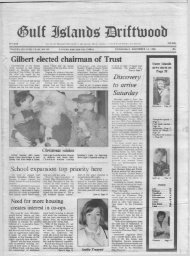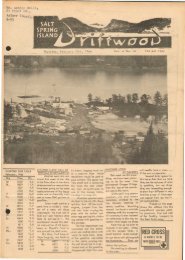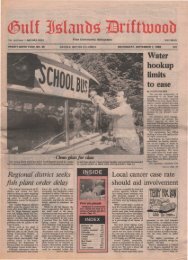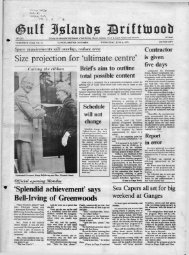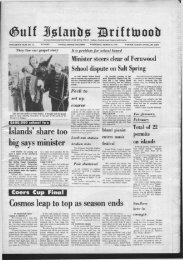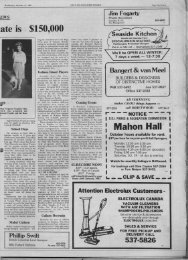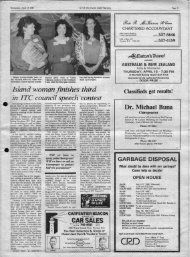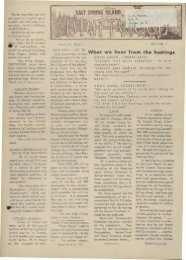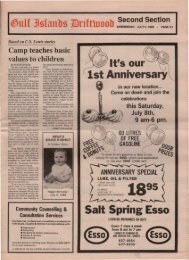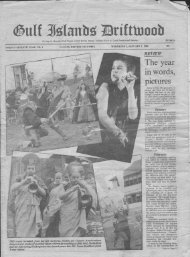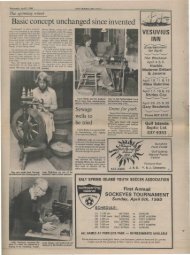Page 24 GULF ISLANDS DRIFTWOOD Wednesday, March 18, 1987By MIKE TURKKIAt 28, <strong>Salt</strong> <strong>Spring</strong> <strong>Island</strong> residentBrien Foerster has alreadydone more than many peopleaccomplish in a lifetime. Amongother things, he's been a universitystudent in Victoria, a computeroperator in Chicago, an actor inEurope and a federal fisheriesworker in Vancouver. He eventried his hand at wine-making in afamily-run operation in Switzerland.But after sampling these careersand lifestyles, this graduateof Gulf <strong>Island</strong>s Secondary Schoolreturned to <strong>Salt</strong> <strong>Spring</strong> to pursuehis first love: carving.Foerster, born in Penticton,moved to the West Coast with hisfamily at the age of 11. He soondeveloped an appreciation forWest Coast Indian art, and startedcarving bits of mahogany witha utility knife."I never was interested in ituntil we moved here," he recalls."I started carving when I was 11,seriously when I was 12. I metJim Gilbert (a well-known nativecarver from Sidney. He wasabout 30 years older than me, andhe started me off by giving me amask that his father had leftunfinished when he died. Oneside was done, and he (Jim) toldme to see if I could copy it on tothe other side."That was Foerster's introductonto three-dimensional carving.When he completed the mask(which now hangs in his livingroom), Gilbert suggested he trycarving a miniature Haida canoe.The native artisan provided hisyoung apprentice with a modelhe'd completed.Foerster made a faithful reproductionof the piece. He went onto serve a three-year apprenticeshipwith Gilbert, and in 1976received additional instructionfrom Richard Hunt, head Kwakiutlcarver at the British Columbiaprovincial museum. Using theknowledge he received from theseprofessionals, Foerster began todevelop his own style.Oddly enough, Foerster neverstudied art in high school. "Theonly art I did in school was inGrade Seven," he notes with achuckle, "when they gave uscharcoal and a piece of paper andsent us outside to draw something.I wasn't really into it, butthey were giving three bucks tothe winner, so I did it. I managedto win, too, which was prettyincredible."Foerster didn't really considerbecoming a professional carverduring his teen years. ("It wassomething I thought I'd do when Iretired, after I'd made a millionbucks doing something else," henotes.) After graduation, he leftthe island like so many of hisclassmates; yet his road to discovery,unlike those travelled by somany others from this area,eventually brought him back to<strong>Salt</strong> <strong>Spring</strong>.Foerster enrolled at the Universityof Victoria, where he studiedmarine biology. "I didn't reallyplan a career in it, I studied itbecause*I wanted to know aboutthe natural world," he explained.After spending two years atUVic, he travelled to Chicago,where he took a job with a largefirm as a computer operator.After living on <strong>Salt</strong> <strong>Spring</strong> <strong>Island</strong>,the big-city environment was'something else.' Foerster discoveredhe missed his home island'srural atmosphere. "When I wasliving in Chicago, I regularlywatched Little House on thePrairie because it depicted thatkind of life."His love of art wasn't lost,however. He did quite a bit ofdrawing while living in the WindyCity, but eventually decided toquit his job and travel to Europe.His employers offered to makehim manager of their word-Wandering path led Foersterback to <strong>Salt</strong> <strong>Spring</strong>, carvingprocessing department, but he'dalready made up his mind to go.After returning from the overseastrip, he went back to schooland obtained an honours degreein salmon management. His desireto carve, however, was stillstrong — so strong, in fact, thathe had to send the tools home sohe could work on his thesis. "Ihad my carving tools, and it feltlike they were staring at me."After receiving his degree,Foerster headed back to Europe,where he lived in Switzerland andworked in a family-run winery.He even managed to get a part ina Yugoslavian movie, playing therole of an English knight."I'd actually planned on livingin Switzerland at one time," hesays. "When you think of Switzerland,you have these images ofquaint little villages. But there'It was something Ithought I'd do when Iretired, after I'd made amillion bucks doingsomething else.'are actually four million peopleliving there in a country smallerthan Vancouver <strong>Island</strong>. Europe isreally crammed."Disenchanted, he came to Vancouverand found work with thefederal department of fisheriesand oceans. He also pursued hisacting career, working with acomedy group to produce a showfor Cable 10. "I had lights ofHollywood in my eyes."Foerster soon found, however,that he didn't enjoy life in B.C.'slargest city. The comedy groupsplit up; he saw "the lights ofHollywood dimming.""I hated living in Vancouver,"he recalls. "I was sitting at acomputer all day doing analysis ofsalmon catch data. I never evensaw a salmon, aside from a30-pounder that was hanging onthe wall.Sl^SJ oerst^otem V baamdJa* Tprgjiia"I hated the environment. Itwas horrible . . . and the wholework ethic. I found most of thepeople I was working with didn'tlike their jobs and couldn't waitfor the weekend. It meant theywere enjoying two days out ofseven, which'.to me didn't makemuch sense.V<strong>Salt</strong> <strong>Spring</strong> began to drawFoerster like a magnet. Althoughhe'd brought his carving toolswith him to Vancouver, he hatedlife there so much he hardlytouched them."I spent every single weekendback on <strong>Salt</strong> <strong>Spring</strong>," he recalls,"which was strange for me,because when I spent four yearsliving in Victoria going to school,I'd come back (to the island)maybe on,ce a month."Finally^ Foerster came to therealization that "money by itselfisn't that great, and what's reallyimportant is doing what you loveto do. If the two happen tocoincide, then that's grand." Hesaved his money, and moved backto <strong>Salt</strong> <strong>Spring</strong> to pursue his careeras a carver.He's been concentrating solelyon his artwork for approximatelythree and a half years now.Today, what started as a hobby 17years ago has become a. way oflife for him. He's painting anddrawing, too, and is constantlyexploring new avenues in art; herecently ymcorporated Japanesebrush technique into his drawingsand prints — a notable exampleof the fusion of tradition andinnovation that is central to hiscreative process. He has alsobegun experimenting on the useof traditional painted West CoastIndian designs superimposed on anatural background.In addition to distinctive prints,he creates Indian bentwood boxesformed from steamed cedar, andrecently completed a nine-footHaida totem from yellow cedar.The pole, shipped to Toronto lastweek, will stand in the newwarehouse-office complex of adventure-clothingdesigner AlexTilley. Other Foerster originalscan be found in the privatecollections of architect ArthurErickson, Senator Jack Austinand Robert Bateman, as well asthose of collectors in the U.S.,England, Ireland, Germany, Switzerland,Hungary and Japan.He is currently working on aThunderbird carved from cedar,as well as an authentic mask. Atany one time, his Montieth Driveworkshop is likely to contain anumber of pieces in varyingstages of completion. "I prefer towork on a couple of things at onetime, because if you do only onone thing and see it through tocompletion, the carving processbecomes simply mechanical," heexplains.Foerster's works reflect notonly the traditional values ofWest Coast Indian art, but hisown deep personal feelings forthe land and the creatures thatpopulate it. "Being Indian isessentially a state of mind," heclaims. "It consists in that certainlove and knowledge of naturewhich Indian art is uniquelycapable of expressing." It is thisunderstanding of the art form thathas made him one of the fewnon-native carvers of West CoastIndian art whose works have beeraccepted by the native people.Yet Foerster also draws theinspiration for his work from <strong>Salt</strong><strong>Spring</strong> <strong>Island</strong> itself. "This isliterally the best place in theworld," he claims. In the briefpause that follows, the sound of awaterfall located somewhere inthe gully behind his home can beheard. "It's close to Vancouverand Victoria, but far enough awaythat you get that rural atmosphere.Yet it's not so backwardthat you have to buy yourflour in 100-pound sacks."
Wednesday, March 18, 1987 GULF ISLANDS DRIFTWOOD Page 25Argentina home to more thansentimental songs, gauchosBy ANDREW GIBSONYou'll find your life will beginThe very moment you 're inArgentina;If you're romantic, senorThen you will surely adoreArgentina.Canadians spend quite a bit oftime thinking about othercountries — the U.S.A., CentralAmerica, Britain, France, Israel,Iran, South Africa and manyothers — but we rarely concernourselves with Argentina, thecountry which is our SouthAmerican counterpart.Our usable land masses aresimilar, as are our populations. Weare flanked by huge, populousneighbours and, insistentlycelebrating our nationhoods, welook uneasily toward our polarsovereignties. We have literate andpolitically sophisticatedcitizenries.It is therefore strange that ourknowledge of Argentina is oftenlimited to the following: it is thehome of the gaucho and the tango;the songs Down Argentina Way,(see above) and Don't Cry for Me,Argentina, from Evita; and therewas a military coup a few yearsago, the military made a lot ofpeople disappear, then lost a sillywar and was thrown out.By chance my own experiencewith Argentina began nearly half acentury ago, in 1938, when I was asea-feverish landlubber fromToronto. I went to England andsoon found myself on a rustyBritish tramp ship, wallowingthrough the South Atlantic swellstoward The Plate, the Rio de laPlata of Imperial Spain.I was fascinated (andscandalized) by beautiful, naughtyBuenos Aires, but even had Iwanted to, I was too poor to sin inthe La Boca dives where,according to the lurid accounts ofmy more affluent shipmates, thearteries of sailors were nightlymade to pop like pipestems by thesight of totally nude girls.I had studied Spanish at school,so I spent my time innocently at theplazas, listening to the bands andtalking to anyone who would talkto me — not, alas, the nice girls,who, beautiful, demure and quiteunapproachable, proved that inArgentina, as in other Latincountries, the girls when they weregood, were very very good Ibutwhen they were bad they wereshameless.I found Argentina enchantingand was delighted when, havingdischarged our coal, there was noMade immediately before his untimelydeath in 1984, CONFIDENTIALLYYOURS (Vivtment Dimanche) is directorFrancois Truffaut's affectionate farewellto the 40's Hollywood thrillers & 30's sexwar comedies that he so loved. Jean-LouisTrintignant plays the grumpy real estatebroker who is falsely charged with threecounts of murder. On the lam from the law,he leaves it to his Girl Friday {FannyArdant) to clear his name and see thatjustice is done. The richly romantic blackand white visuals are provided byTruffaut's brilliant cameraman. NestorAlmendros. Suspense and humour arekept in perfect balance by a New Wavemaster with a special feel for both moods.Mature—occasional violenceMONDAY, MAR. 238 pm — Central HallEVERYONE WELCOME9\9 9 9 9 9 9 99 9 #•outward cargo for us, so we weresent up the silt-brown ParanaRiver to await one, in companywith a score of the world's mostdisreputable tramp ships. A mileaway was the small town of SanNicolas.We were there for three months,and I was probably the only one onboard who was sorry when wefinally weighed anchor andsteamed upriver to Rosario, for acargo of grain. Our Scots andTyneside crew thought longinglyof the damp delights ofSauchiehall Street and King'sRoad, but I thought semi-tropicalSan Nicolas glamorous. I'd evenmade Argentine friends, and hadbeen given the signal honour ofbeing allowed to promenade theplaza with a young lady — plus, ofcourse, her mother, father andbrothers. For a proper Argentinesenorita to be without such a possewas quite unthinkable.I still remember the perfumedair, the music, the girls and theboys, in groups, walking inopposing directions, the better tomake discreet eye contact, and thecourting couples with theirinevitable chaperones. I wastempted to jump ship.I was back to the Argentineagain, the next year, toConcepcion, up the clear fastflowingUruguay River — but thistime only for k couple of weeks.We had discharged our cargo atBuenos Aires, and had beenberthed opposite a North GermanLloyd cargo liner, gleaming withpaint and swarming withuniformed sailors.Our poverty-stricken rust-redtramp, with her motley crew,seemed to suffer by comparison,but in one respect we shone. At hertaffrail fluttered the swastika, andone sight of that was enough forour cabin boy, a young Jewishcockney. He didn't appear on deckon the side facing that dreadedflag, and he didn't go ashore at alLIt was 1939 and a warning as loutias an approaching train, butinaudible to our leaders, hadreached him about what was instore for his people. For him therewas an almost visible miasma ofhate between the two vessels.Then, of course, I was obliviousto politics (after all, R.B. Bennett,Mackenzie King, Stanley Baldwinand Neville Chamberlain weren'tlikely to turn one on). The SecondWorld War came and went and Ibecame a landsman again, but Inever forgot Argentina, andfollowed her turbulent affairs —Peron, Evita, the coups and, adecade or so ago, her dreadfulsubmergence into the horror of amilitary despotism which, as in toomany Latin-American countries,then and now, prattled endlesslyabout honour while torturing andmurdering. Then, as a silver liningto the foolish Malvinas affair,came the overthrow of the generalsand a return to humanity.My wife and I had three reasonsfor going to Argentina: nostalgia (Iwanted to go back to where I hadbeen in my youth), my wife hadn'tbeen south of the equator (shewanted to see the sun in the northat noon, and at night the SouthernCross), and we both wanted to seehow Argentina was doing threeyears after her generals, likemultiple Old Men of the Sea, hadbeen hurled from her shoulders.— (to be continued)Foxglove FencingGreat prices on the best selectionof fencing & posts in the islands!HEAVY GAUGESTOCK WIRE 330' roll, 47" highHEAVY GAUGESTOCK WIRE . 330' roll, 32" highDEER FENCE7MED. GAUGE DEER or%POULTRY FENCE 10 Off6o-nighPRESSURE TREATEDWOOD POSTS 2Vi"x T 2.49 I s 3.092 h i gho r119999595PAINTED 6 ft. 7 ft. 8 ft.STEEL POSTS 3.69 4.19 4.89ACk 95STUCCO WIRE 4x112POULTRY WIREAvailable in 2, 3, 4, 5 or 6 ft. widths,1" or 2" mesh, 25 ft. or 100 ft. rolls. Any sizeINLY20%OffREMEMBER: We also carry Kennel Wire, Berry Wire,Staples & Electric Fencing.NEW! CEDAR LATTICE FENCING. Attractive & easy toinstall—or let us install it for you.WE DELIVER.FOXGLOVE FARM& GARDEN SUPPLYSale runs March 11-18 9:30-5:30, Mon.-Sat.Amnesty film featuredFree at Last, a film made for Amnesty International, will be shownat the <strong>Salt</strong> <strong>Spring</strong> <strong>Island</strong> chapter's annual general meeting onThursday, March 26.Personal portraits are a focus of the film: "What crime have wecommitted? Defending human rights, that is 6ur crime," says apeasant leader in Peru, on the day he is freed. Also on film,describing their return to freedom, are a former prisoner releasedfrom the USSR, a survivor of torture in India and a Latin Americantrade unionist.The film also profiles Amnesty International volunteers at work inJapan, Spain and Great Britain, "and shows how people can worktogether for the release of prisoners of conscience and on behalf ofvictims of torture and execution," the release says.The annual general meeting, meanwhile, will deal with the electionof officers, reports from executive members and plans for the comingyear.The meeting, open to the public, will be held in the <strong>Salt</strong> <strong>Spring</strong>Elementary School library, beginning at 7:3Q?pm. Refreshments willbe served.DIAL-A-LAWLEGAL INFORMATION JUST A FREE PHONE CALL AWAY!Find out about your legal rights. Learn about specificlegal topics. Pre-recorded tapes give you legal informationon 125 different subjects of common concern. If yourequest, you may be referred to other organizations for.further assistance.DIAL A LAW (TOLL-FREE LINE) 1-800-972-0956.Service available Monday-Friday 8:30 attii. to 4:30 p.m.A public service of the B.C. Branch, Canadian BarAssociation, funded by the Law Foundation of B.C.Puerto Plata . . .Visited and EnjoyedBy MARGUERITE LEEOn the wall of our office is a mapwith flags marking all thedestinations that have been visited bythe staff. When Patrick and I decidedto have some fun in the sun, I wantedto put a new flag on the map! Aftermuch discussion, the DominicanRepublic in the Caribbean waschosen. Located S.E. of Cuba, itshares the island of Hispaniola withHaiti. My only knowledge of thedestination at that time was that itwas the site of the first landing ofChristopher Columbus in 1492.The simplest and most economicalway to get there would have been tofly to Toronto and connect to a nonstopcharter to the DominicanRepublic. Like most of my clients, Ileft it too late and found the chartersfull for the period that we could go.Thus began our adventure—Victoria, Seattle, Atlanta, Miami,Port-au-Prince and finally PuertoPlata.Arriving late at night in the airportat Puerto Plata, we were hustled withour baggage by "helpful" locals in amanner that left us breathless! A taxiride through sugar cane fieldsbrought us to the resort area for$7.50 CAD.The resort accommodations varyfrom hotel rooms to two bedroomcondos. Built in the last 5-6 years,they are well appointed. Constructedback from the beaches, a green belt isleft to preserve the natural beauty ofthe shoreline. And beautiful it is! Thewhite sand beach goes for miles andis paralleled by lush trees so there is ashady spot for everyone. Crowding isnot a problem. The clear aqua waterwas warm for swimming and withoutsurf. Snorkelling is possible over thecoral outcroppings. Windsurfers andlaser-type sailing vessels are availablefor the more energetic.For those who like to walk thechoice is yours: unlimited beaches orroads through beautiful gardens.Bicycles are free and the terrain isflat. Motorscooters for one or twoare available for a small charge andare great fun for the afternoon.Horsedrawn carriages will take youthrough the grounds at no cost, but itis recommended you tip the driver.The Robert Trent Jones Golf Courseis exceptional in layout. The fairwaysare long and undulating throughsuperbly landscaped grounds.Costing $20 CAD for 18 holes,golfers think they are in heaven.Meals are excellent andrestaurants plentiful. They offereconomical to gourmet dining andgenerally speaking, the cost is lessthan what we pay here. The mostexpensive meal in a gourmetrestaurant was Lobster Thermidor at$19. A pizza that fed four of us forlunch was $10. Outdoor dining ispopular because the evenings arewarm enough that a sweater or jacketis not necessary.The Dominicans are friendly andhelpful. Those involved in tourismspeak Spanish, English and French,but shopkeepers and service peoplehave limited English. They all love tosing to meringue music is playedaround the pool areas and in therestaurants.The old colonial town of PuertoPlata has narrow streets and crazydrivers. Vehicles are dilapidated anddriven with horns constantly beepingand arms waving! A ride on the localbus to town costs 12 cents but isworth unlimited value inentertainment. Designed for 15people, it stops and picks upwherever and whenever is necessary.At one point we have 29 people insideand hanging out of the bus, plus thelocal fisherman with his catch andspeargun, on the running board . . .Don't miss it!If you prefer a more conventionaltrip, a taxi will take you into town,wait 2 hours while you shop, andreturn you to your hotel for $12.50.Needless to say, you pay at the end ofyour journey.Our days were full with tennis,bicycling, swimming, dining,shopping and being a tourist. At theend of our stay, there were still manyactivities that we had notexperienced. Perhaps there will be anext time for us.537-9911Mon.-Fri.9:00-4:30



